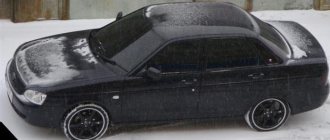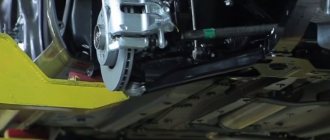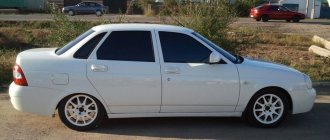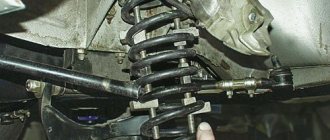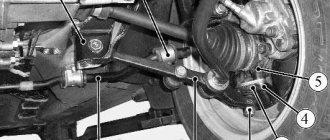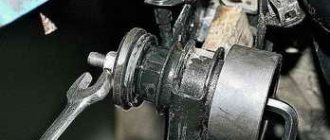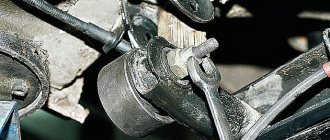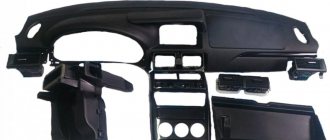Passenger cars of the “Tenth Family” were produced by the VAZ plant in the early 2000s. These include the Lada-112 hatchbacks, the design of which is considered the most successful. On the VAZ-2112 the front suspension is designed in the same way as on station wagons or sedans. And it is more complex than on all Logan family cars. The reason is the absence of triangular levers. But in the VAZ-2110 (2112) suspension you can adjust literally everything, while in Logan we only adjust the toe.
Sometimes the suspension unit is tuned. But what is shown in the video should not be repeated. Let's see...
Front suspension device
The front suspension
is independent, with telescopic swivel struts, wishbones, trailing arms and a stabilizer bar.
Front suspension:
1 - cross member; 2 — cross member bracket; 3 — adjusting washers of the front end of the extension; 4 — longitudinal stretch; 5 — telescopic stand; 6 — steering knuckle; 7 — adjusting washers of the rear end of the extension; 8 — ball joint; 9 — wishbone; 10 — stabilizer strut; 11 — rubber-metal hinge; 12 — car body bracket; 13 — stabilizer bar; 14 — rod cushion bracket
The suspension strut consists of a housing in which a hydraulic telescopic shock absorber is installed, a coil spring and an upper strut support. A bracket for attaching the steering knuckle, a swing arm and a lower spring support cup are welded to the outside of the strut body.
The coil spring rests with its lower coil on the lower support cup, and with its upper coil on the upper support cup mounted on the shock absorber rod. Also installed on the shock absorber rod is the upper support of the strut, consisting of a housing, a rubber cushion and a bearing. The support body is attached to the car body with three studs and nuts. The bearing allows the shock absorber rod to rotate in the support when the strut is turned, and the rubber buffer prevents the transfer of vibrations to the car body.
The shock absorber rod is protected from dirt and dust by a corrugated casing. In the event of a suspension breakdown, the stroke of the rod is limited by the compression stroke buffer.
The strut pivot arm is connected to the steering rod through a ball pin. Changing the length of the rod using its threaded insert allows you to adjust the toe-in of the front wheels.
1 — tie rod end 2 — threaded insert; 3 — steering rod; 4 — telescopic stand; 5 - rotary lever
The steering knuckle is attached to the strut bracket with two bolts and nuts. The upper hole of the bracket is made oval, and the bolt installed in it has an eccentric collar and an eccentric washer. When the top bolt is turned, the steering knuckle moves along the radius the required distance, using the bottom bolt as the axis of rotation. Thanks to this, the angle between the strut and the fist changes, which in turn allows you to adjust the camber of the front wheel.
1 — bracket for fastening the steering knuckle; 2 — rack body; 3 - upper (eccentric) steering knuckle mounting bolt; 4 - lower steering knuckle mounting bolt; 5 - steering knuckle
A double-row ball bearing is pressed into the hole of the steering knuckle and secured with two retaining rings. The wheel hub is pressed into the inner ring of the bearing.
At the bottom, the steering knuckle is connected to the wishbone of the suspension using a ball joint. The transverse lever is kept from moving by a stretcher, which is attached at its rear end through a rubber-metal hinge to the lever, and at the front end through a cushion to the cross member. By changing the number of washers in the front and rear brace mounts, you can change the position of the lever, thereby adjusting the longitudinal inclination of the steering axis.
1 — rear end of the longitudinal extension; 2 — adjusting washers; 3 - thrust washer; 4 — rubber-metal hinge; 5 - transverse suspension arm
The ends of the anti-roll bar are connected by struts to the wishbones of the vehicle's front suspension. The central part of the stabilizer is secured through rubber pads to the body. The movement of one of the levers is transmitted through the stabilizer to the second. This allows you to partially synchronize the operation of both sides of the suspension and thereby reduce the sway of the car on uneven roads and roll in corners.
Source
Knocks
If you start to hear knocking noises coming from the front suspension, this could be caused by several reasons:
- The rack has certain faults;
- The ties on the cross member, the cushions are worn out or the bolts are loose;
- The attachment to the body was not strong enough;
- The springs have failed;
- The hinges are worn out;
- The rubber part of the suspension has broken its integrity. The knock should be clear, like the impact of metal on metal;
- Wheel alignment is out of balance.
Review of the front suspension of the VAZ-2112 and what parts it includes: structure and diagram
Passenger cars of the “Tenth Family” were produced by the VAZ plant in the early 2000s. These include the Lada-112 hatchbacks, the design of which is considered the most successful. On the VAZ-2112 the front suspension is designed in the same way as on station wagons or sedans. And it is more complex than on all Logan family cars. The reason is the absence of triangular levers. But in the VAZ-2110 (2112) suspension you can adjust literally everything, while in Logan we only adjust the toe.
Sometimes the suspension unit is tuned. But what is shown in the video should not be repeated. Let's see...
Loading, Please Wait!
This may take a second or two.
Before you start repairing anything, you need to know how it works. Therefore, the first article in this section is the design of the front suspension. What is front suspension and what does it consist of?
The suspension is the parts, components and mechanisms that connect the car body to the wheels. The purpose of the suspension is to reduce dynamic loads on the supporting elements. The VAZ 2110 has an independent, telescopic front suspension.
Front suspension - complete assembly
The photo shows what the right disc suspension looks like. It is easy to recognize the telescopic post 6, as well as the lever 3. Both of these parts form the basis of the assembly.
We list the main parts in ascending order of number: 1 – anti-roll bar; 2 – stabilizer rod; 3 – suspension arm; 4 – ball joint; 5 – steering knuckle; 6 – suspension strut; 7 – stretch (saber); 8 – extension bracket.
Parts 7 and 3 could constitute a "monolith". But even then they would be mounted on hinges, and in the suspension design of the VAZ-2112 (and 2110) we will find these hinges plus one more - it connects parts 3 and 7.
The photo does not show the swing arm, but here it is attached to the shock absorber, that is, it is part of it.
The main part is a strut with a shock absorber
Everything that is indicated above by the number 6 consists of several parts. Let's list them.
The numbers indicate the elements:
- 2108-2901056 – metric nut M14;
- 2110-2902760 - cup;
- 10519601 - washer;
- 16105021 – self-locking nut M12;
- 2110-2902816 – bump stop;
- 2110-2905003 and 2110-2905002 – shock absorber left and right;
- 2110-2902826 - frame;
- 2108-2901052 – washer for screw;
- 15540931 – M12 screw (until 07.2001);
- 2108-2901051 – lower screw (after 07.2001);
- 2110-2901054 – cap;
- 2110-2902842 - washer;
- 2110-2902830 – screw;
- 2110-2901032 - washer;
- 2110-2902820 – upper support (pillow);
- 2112-2902712 – suspension spring;
- 2112-2901031 and 2112-2901030 – left and right rack;
- 2110-2905681 – anther;
- 2108-2901050 – screw with eccentric;
- 16104111 – self-locking nut M8;
- 2108-2902840 (-01, -02) or 2110-2902840 (-01) – support bearing.
Some station wagons and sedans have racks 2110-2901030 and 2110-2901031. But then springs 2108-2902712 are used. But the parts marked with the number 21 are interchangeable.
Rounded fist
Let's consider one important unit, consisting of a minimum number of parts.
Steering knuckle with hub bearing
From the appearance of the unit it is clear what and how it is attached to. Let's list the articles:
- 2108-3103020-01 (-02) – wheel bearing;
- 2108-3103068 – sealing ring;
- 2108-3001060 – dirt protection lining (internal);
- 2108-3103012 – hub;
- 2108-3103079 – bearing element (washer);
- 2108-3103032 – a retaining ring that secures the bearing;
- 2108-3001061 – dirt protection pad (external);
- 2110-3103065 – decorative cap (after 01.2003);
- 2108-3103065 – decorative cap (until 01.2003);
- 2108-3001015 and 2108-3001014 – left and right fist;
- 2108-3103061 – hub mudguard;
- 14044271 – self-locking nut M20.
Lever and everything connected with it
The lower arm holds the ball pin (part 2). The steering knuckle is attached to the ball joint housing. It is not shown in the drawing, but fastening screws 15 are shown.
Levers together with saber stretchers
- 2108-2904046 – rear hinge of the saber;
- 2108-2904185-01 – ball pin;
- 10517070 – spring washer;
- 2110-2904192 – ball joint;
- 15541231 – M12 screw;
- 2108-2904045 – thrust washer;
- 16105011 – self-locking nut M12;
- 2108-2904040 – swivel joint;
- 2108-2904020 - lever arm;
- 2108-2904270 – saber or stretcher;
- 12638601 - washer;
- 2110-2904070 – casing;
- 2110-2904076 – spacer sleeve;
- 12574921 – self-locking nut M16;
- 15970730 – M10 screw;
- 2108-2904225 – spacer washer (maximum number – 4 pcs.);
- 16101521 – metric nut M12;
- 10516870 - spring washer.
How to upgrade wipers
In most cases, the windshield cleaning area will be improved. In principle, there is nothing complicated here. But first you can change the wipers if they do not cope with their function
It is worth drawing your attention to the fact that from the driver's side the visibility should be 100%, especially on the left. Dirt appears right on the left pillar side, which the wipers cannot cope with.
One of the outputs is to adjust the position of the device. In our case, it is necessary to slightly raise the driver's wiper, that is, change its initial position. But not everyone will like this method, and the result is not 100%, since some of the dirt still remains. In this case, a slightly different modification to the VAZ-2110 wipers will be required.
Sometimes the cause is a windshield that does not allow the glass to be cleaned evenly. In this case, for a more noticeable result, you need to bend the frill leash. You can direct the hook under the brush; near it we need to bend the leash a little. There's already a factory bend there that we need to make a little bigger. In addition, you need to bend the end of the wiper spoiler slightly upward. This is done so that it does not catch the brush. After this, it is advisable to check if everything worked out for you. That, perhaps, is all that needs to be done on the VAZ-2110. Modifications to the wipers, of course, are different, but they are done quite quickly and simply, so you will succeed
Now let’s move on to something no less important – the car’s heater, which warms us up in the cold. There is a lot you can do here, but let's talk about the most important thing.
View gallery
Diagram of the anti-roll bar on the VAZ-2112
The stabilizer is an important part, but you can drive without it. The absence of a stabilizer is not a reason to remove the car from service.
Stabilizer and traction rod
The unit consists of a rod and two rods. Articles:
- 2110-2906050 – thrust or stand;
- 2110-2906010 – assembly assembly;
- 10516870 – spring washer;
- 2110-2906040 - pillow;
- 10519601 - washer;
- 2108-2906042 - bracket;
- 2110-2906016 – rod;
- 2110-2906078 – upper rod bushing;
- 15971321 – M10 screw;
- 12164711 – nut M10;
- 16104111 – self-locking nut M8;
- 2108-2906079 – lower rod bushing.
To get rid of the stabilizer, remove the parts shown in the list.
Controllability
It would seem that the reduced base (when compared with the “ten”) should have made the car more obedient, but for some reason everything is different with the “two”. Handling here is very mediocre. When turning, you often have to fight with the steering wheel, which constantly strives to return to its original position. There are cars without power steering, the driving of which gives little pleasure, and the steering wheel seems to be filled with lead and generally refuses to rotate adequately.
Lada 2112 (1999–2008)
When cornering, the body often begins to sway and roll to the side, causing the wheels to lose traction on the asphalt. This happens especially often on rough roads. It is better not to accelerate too much in the VAZ 2112, because at high speeds you can easily lose control.
Front suspension device on the VAZ-2110 device, design
Front suspension VAZ-2110: device and design
Why a suspension is needed and what responsibility it bears, everyone knows from driving school, if not from school
Therefore, we will not focus on general maxims, but will immediately get down to business
The VAZ-2110 inherited from the eight and nine the MacPherson suspension, developed back in the 70s of the last century and tested on the experimental VAZ-2108.
Of course, adjustments were made to the design and today it looks like this:
As can be seen from the diagram, there is nothing complicated in the design, and there is nothing superfluous. The Spartan suspension of the tenth family is of the type of independent suspension with hydraulic shock absorbers, coil springs 7 on the lower (23) wishbones. The right and left levers are hinged, using silent blocks, connected by a stabilizer bar. A stabilizer is necessary to maintain vehicle stability in turns and during active maneuvering. It is a rod made of springy steel with a bend for the muffler.
Front pillar
The most important, expensive and maintenance-requiring unit is the front shock absorber strut (16).
There's a suspension strut hidden somewhere here!
In the lower part, the rack is attached to the steering knuckle 19 using two bolts, one of which (18) is eccentric. By turning this bolt and releasing nut 17, the camber angle of the front wheels is adjusted. The front spring rests on the support cup 6 from below and on the upper support cup 10. To prevent breakdown of the suspension, a compression damper 9 is installed on the shock absorber rod.
The stand itself rests on top of cup 12, which is assembled with a rotary bearing 11. The upper support is a separate unit, it is fixed to the body mudguard using three self-locking nuts. The support has some elasticity in order to absorb high-frequency vibrations and not transmit them to the body, and free rotation around its axis by the rack and the front steered wheel is ensured by the upper bearing 11 and the lower ball joint 1.
The front struts are oil-based and dismountable.
Front suspension springs.
Front strut shock absorbers and protective covers.
The working shock absorber is installed in the strut housing. If necessary or when choosing a different type of shock absorber (gas, gas-oil), it is always possible to remove it from the strut body, repair or replace it. It should be taken into account that the figure-eight shock absorber is not suitable for the ten, since the strut body on the 2110 is shorter, although the design looks identical.
Ball joint and lower control arm
It is the ball joint that takes on all the loads - braking, accelerating, longitudinal and transverse, and in addition, it is the lower point of support of the steering knuckle.
Ball joint fastening unit.
Support 1 is fixed on the lower arm using three blind bolts. When disassembling this unit, you need to be extremely careful, since the holes in the steering knuckle for the support mounting bolts are not through and if handled carelessly, you can easily tear off the heads or break the body of the bolt. If this happens, you will have to drill out the remaining bolt or change the steering knuckle. This is labor-intensive and expensive work.
Lower suspension arm with silent blocks.
Stretch marks
To prevent bending of the lower arm and relieve braking and accelerating loads from it, braces are attached to it, the second end of which is fixed through a silent block to the front suspension beam.
Front suspension of VAZ-2110.
The stretchers perform another important function: they help regulate the longitudinal inclination of the rotary axis. This angle greatly affects the stability of the vehicle and its behavior when maneuvering. Adjustment is carried out using washers installed at both ends of the stretcher.
Rounded fist
An equally important detail is the steering knuckle.
Steering knuckle and hub assembly.
It is he who is responsible for the safety and fixation of the wheel bearing. The bearing is held in the fist by two retaining rings. Bearing type: angular contact, double row. It does not require adjustment throughout the entire period of operation.
The hub itself is pressed into the inner race, and it is secured with a nut, and the nuts on the right and left are the same and have a right-hand thread.
conclusions
In short, this is how the VAZ-2110 suspension works. We examined only the basic elements of the design, but the essence is clear - repair and maintenance of the front suspension is not at all a complicated procedure, the main thing is to know its structure and promptly identify and eliminate faults. Take care of your suspension and let only smooth roads under your wheels!
Spherical bearing
The VAZ 2110 front suspension arm is attached to the hub using a ball joint. If you have consulted the reference literature, you may know that this node is practically invulnerable. It is difficult to break it and put it in bad shape. Unfortunately, the support still breaks. And its resource largely depends on the following factors:
Very often, it is because of a ball failure that a knocking sound appears from the front suspension of the VAZ 2110. Moreover, it can be observed both when the car is moving and when passengers are boarding and disembarking. And it doesn’t matter how fast you move or which direction you turn. But knocking in the suspension is not uncommon. And if it appeared due to a ball joint, then repairs will not be very expensive.
Rear suspension of VAZ 2107
The rear suspension of “classic” VAZ cars is directly connected to the rest of the chassis. The rear suspension of the VAZ-2107 includes a driving rear axle, which is connected to the car’s engine through a cardan drive and the rest of the transmission. The wheels are oriented strictly in the direction of travel of the car. These conditions determined the features of the rear suspension of the VAZ-2107. Like the front suspension, the rear suspension is a modernized version of the first VAZ model.
The figure below shows the rear suspension structure of the VAZ-2107. Number 1 shows the thrust spring between the axle (4) and the car body. Number 2, telescopic shock absorber dampening sudden vibrations. Transverse reaction rod 3 prevents the bridge from moving to the sides from the vehicle axis. Longitudinal rods 5 and 6 fix the position in the direction of travel. This arrangement of nodes allows you to compensate for road unevenness.
Possible breakdowns
If you hear a knock in the front suspension while driving, the main reasons may be:
- Faults in the rack;
- The bolts have become loose, the stretch marks or cushions with which the cross member is equipped may have worn out;
- The attachment to the body has become loose;
- The rubber parts have collapsed, and the knocking has a distinct “metallic” sound;
- A “limp” or even a broken spring knocks;
- Wear of hinges;
- Knocking due to wheel imbalance.
In principle, in any of the listed cases, repairing the VAZ 2110 front suspension, done by yourself, can help, during which you need to replace a worn part or (in the latter case, the reasons why a knock is heard) - balance the wheel.
Vehicle pull to the side
The car pulls to the side when driving straight. The reasons for this malfunction may include:
- Each spring has its own compression ratio. In this case, the spring that has lost its elasticity must be replaced;
- Tires have different pressures. We check and correct;
- The rubber element near one of the strut supports was destroyed. At the same time, a characteristic knocking sound is also heard while driving. The problem is solved by replacing this element;
- The wheel alignment angles are incorrect. Increased tire wear may be associated with this malfunction. If you can’t handle it yourself, it’s better to entrust this task to specialists.
Encyclopedia of tuning and modifications for VAZ 2110, VAZ 2112
| Helical suspension (coilovers) allows you to easily adjust the car’s suspension to different operating conditions. But such adjustable shock absorbers have one big drawback - their high price (a set from 50,000 rubles). Want to save money? Try making homemade coilovers. |
| One of the popular ways of tuning a car is to lower it. To do this, the suspension is modified using different methods, for example, cutting off the springs (which is not recommended), installing a lowered suspension kit, installing air suspension, or using suspensions with adjustable clearance. I will dwell on the last method in more detail. |
| On the VAZ 2110 (and some other front-wheel drive cars), rubber silent blocks are used in the cross member of the front suspension. To change the characteristics of the suspension and handling, they can be replaced with rubber-metal hinges (popularly “daisies”). Let's look at this improvement in detail. |
| Car silent blocks are hinged elements that serve to connect parts of the front or rear suspension and dampen vibrations transmitted from one unit to another. Most often they are made of rubber, but for tuning enthusiasts they offer polyurethane silent blocks. Do you know what is better to choose polyurethane or rubber? |
| Buffers are interturn spacers made of durable and elastic material designed to increase the stiffness of suspension springs. According to the manufacturers, these accessories can not only make the ride more comfortable, but also extend the life of the suspension and increase ground clearance. They claim that the installation of an auto-buffer is comparable in its characteristics to the installation of an additional shock absorber and gives the effect of an air suspension. Is this really so? |
| If the car falls into a deep hole, cracks in the paintwork may appear on the strut support. Most often, Kalina owners encounter this defect, but older VAZ models (2108-21099, 2110-15) are also no exception. To extend the life of the body, there are special protective spacers that can protect weak points from damage, as well as prevent the further spread of existing cracks. |
| For the first time at AvtoVAZ, negative camber of the rear wheels was used on the sports Kalina. Later, minus camber of -1 degree was used on Grant and the new Kalina. Do you know how to make negative camber on a VAZ with your own hands? |
| AvtoVAZ recommends installing wheels with a camber angle of 0 degrees. When the wheels are parallel to each other, good traction and stable driving are ensured. Do you know why they do negative camber and how it affects the behavior of the car? |
| Many car owners complain about insufficient handling due to weak body rigidity and suspension mounting points. This problem can be solved using an integrated approach to improving the driving performance of the car - installing a subframe. |
| On front-wheel drive VAZ cars, the rear suspension is semi-independent (torsion bar), which has its advantages and disadvantages. To change the characteristics of the car, the rear suspension is changed to independent. Do you know how complicated this process is and what impressions you get after such tuning? |
| At the front of the car, as a rule, an independent MacPherson-type suspension, double-wishbone or multi-link suspension is installed. But the rear suspension may have significant differences. Depending on the car and its operating conditions, the rear suspension is dependent, semi-independent or independent with a different number of levers. Each design has its own characteristics, advantages and disadvantages, and which one is better? |
| Do you hear extraneous noise in your car when driving? You should not delay in finding the cause of the malfunction, but repair the failed part as quickly as possible. The table describes the main causes of noise when driving a car, as well as ways to eliminate the problem. |
| During the operation of the car, we involuntarily have to deal with the appearance of extraneous noise, no exception knocking or squeaking when turning the steering wheel. In this article, we will look at the possible causes of this problem and how to fix it. |
| The front struts of the VAZ 2110 are designed to absorb shocks and impacts on the car body. Their approximate service life is 60-100 thousand km. mileage, and it largely depends on operating conditions. If you notice that the car has become less stable on the road, replacing the shock absorbers will most likely solve the problem. |
Spherical bearing
If there is a knocking sound from the front suspension of the VAZ-2110, there is a high probability that there is a malfunction in the ball joint. It consists of the following elements:
- Threaded ball pin.
- Metal clip.
- Bolts attaching to the suspension arm.
- Nut fastening to the hub.
- Rubber boot.
Two failures can be distinguished - destruction of the metal ball pin and boot. The latter happens quite often. Water, dust, and dirt penetrate into the mechanism through cuts and cracks. These particles act as an abrasive, gradually destroying the rubbing parts.
Having special equipment for restoring balls, you can repair them. But there is little point in this - the cost of a set of new elements (2 pieces) is approximately 500-700 rubles, depending on the manufacturer. And recovery will not give good results for a long time.
Repair of VAZ 2110 Lada Chassis
4.0 Chassis
Telescopic stand 1 – compression valve body; 2 – compression valve discs; 3 – throttle disk of the compression valve; 4 – compression valve plate; 5 – compression valve spring; 6 – compression valve cage; 7 – recoil valve nut; 8 – recoil valve spring; 9 – valve plate from...
4.1. Checking the technical condition of suspension parts on a car (Category). See the list of materials inside...
4.2. Rear suspension (Category). See the list of materials inside...
↓ Comments ↓
1. General data 1.0 General data 1.1. Vehicle Specifications
2. Engine 2.0 Engine 2.1 Possible engine malfunctions. 2.2 Replacing the coolant 2.3 Replacing the engine oil and oil filter 2.4. Installing the piston of the first cylinder to the TDC position of the compression stroke 2.5 Replacing the camshaft drive belt and tension roller 2.6 Adjusting the camshaft drive belt tension 2.7 Removing, troubleshooting and installing the flywheel 2.8. Replacing engine seal parts 2.9 Cylinder head 2.10 Grinding in valves 2.11 Adjusting clearances in valve drive 2.12 Removing and installing engine 2.13. Engine repair 2.14. Lubrication system 2.15. Cooling system 2.16. Exhaust gas system 2.18. Features of VAZ-2112 engine repair
3. Transmission 3.0 Transmission 3.1. Clutch 3.2. Gearbox 3.3. Front wheel drives
4. Chassis 4.0 Chassis 4.1. Checking the technical condition of suspension parts on the car 4.2. Rear suspension
5. Steering 5.0 Steering 5.1 Inspection and check of the steering on the car 5.2. Steering column 5.4. Steering mechanism 5.5 Possible steering malfunctions.
6. Brake system 6.0 Brake system 6.1. Vacuum booster 6.2. Main brake cylinder 6.3. Pressure regulator 6.4. Brake hoses and tubes 6.5 Bleeding the brake system 6.6 Replacing brake fluid 6.7. Front wheel brakes 6.8. Braking mechanisms of the rear wheels 6.9. Parking brake 6.10 Possible malfunctions of the brake system.
7. Electrical equipment 7.0 Electrical equipment 7.1. Mounting block 7.2. Generator 7.3. Starter 7.4. Ignition switch (lock) 7.5. Checking and replacing spark plugs 7.6. Integrated engine management system (fuel injection system) 7.7. Contactless ignition system 7.8. Lighting, light and sound signaling 7.9. Windshield wiper 7.10 Replacing the electric motor of the radiator fan of the cooling system 7.11. Heater electric motor 7.12. Cigarette lighter 7.13. Instrument cluster 7.14 Checking the carburetor solenoid valve control unit 7.15 Possible malfunctions of the EPHH control unit. 7.16 Electrical diagram of a VAZ-21102 car 7.17 Electrical diagram of a car with a carburetor engine 2110 7.18 Engine control diagram 2111 (pin M1.5.4) 7.19 Engine control diagram 2111 (pin MP7.0) 7.20 Control diagram for engines 2111 and 2112 (pin M1) .5.4N, "January-5.1")
8. Body 8.0 Body 8.1 Possible body malfunctions. 8.2. Replacing the buffers 8.3 Removing and installing the radiator trim 8.4 Removing and installing the locker 8.5 Removing and installing the wing 8.6. Hood 8.7 Removing and installing upholstery, trim and windshield frame lining 8.8. Trunk lid 8.9. Side doors 8.10 Removing and installing the front seat 8.11 Removing and installing the upper and lower lining of the floor tunnel 8.12. Seat belts 8.13. Rear view mirrors 8.14. Instrument panel 8.15. Heater 8.16 Anti-corrosion compounds for body treatment 8.17. Features of body repair of models 2111 and 2112 8.18. Body care
9. Appendices 9.0 Appendices 9.1 Fuels, lubricants and operating fluids 9.2 Basic data for adjustments and control 9.3 Filling volumes 9.4 Lamps used in the car
Engine
There are many modifications to the VAZ 2110 engine to improve its performance. A list of engine changes that tuning enthusiasts can do with their own hands:
- A zero resistance filter is installed in the engine.
- Changes are being made to the fuel supply system to the engine. For example, jets are installed - dispensers that control the amount of incoming fuel.
- A larger diameter throttle valve is installed in the intake system to increase the volume of air supplied.
- The receiver is being modified.
- Direct-flow exhaust is installed. This procedure is considered one of the most common modifications performed by car tuning enthusiasts.
- Various manipulations are performed with the cylinder block. For example, new camshafts are installed.
- The engine cooling system is tuned to obtain a cold intake effect.
Some of these modifications are difficult to do yourself. If you do not have the necessary experience and qualifications, it is advisable to contact a car service center for any changes to the car’s power unit.
Do-it-yourself repair of the VAZ 2110 front suspension Detailed instructions
During the operation of a car, its suspension takes on the greatest load. Not only safety, but also driving comfort depends on the technical condition in which it is located. Today we will try to figure out how to repair the front suspension of a VAZ 2110 at home.
DIY suspension repair
It is worth noting that most of the repair work can be done on your own, without involving expensive specialists and using the services of service centers or service stations.
So, first of all, you need to put the car on the handbrake and secure the wheels with wheel chocks. The entire repair process can be divided into several stages. Let's look at each of them in detail: Repair of ball joints - remove the wheel and clean the suspension elements from accumulated dirt. Using a jack, slightly raise the front of the car. Unscrew the upper ball joint pin nut and press the pin out of the steering knuckle. After it comes out, remove the fastening of the ball joint and remove it from the upper arm along with the protective casing. Install a new device and assemble it in reverse order. The lower support changes in a similar way; Front suspension arms - work begins by removing the upper element, for which the steering knuckle pin is pressed out of the ball joint. Remove the bracket bolt from the bumper and unscrew the fastening nuts from the axle, then remove it, and remove the lever itself from the car. Using a special puller, damaged silent blocks are removed and new ones are installed in their place. Assembly is carried out in reverse order. It is not necessary to remove the lower element, just unscrew the nuts on its axis and, using a puller, remove the rubber-metal hinges, put new ones in their place and tighten the nuts. Removal is carried out only if the part is damaged, which, however, is quite rare;
Shock absorber - to replace this component, unscrew the fastening nut located on its rod. Remove all installed washers and the upper rubber cushion from it. Unscrew the lower shock absorber bracket, which connects it to the lower arm. Remove the broken part through the technological hole. Remove the mounting bracket and install a new shock absorber. Assembly is performed in reverse order.
It is important to remember that even if one shock absorber is broken, both must be replaced;
Spring - first of all, remove the shock absorber and disconnect the stabilizer bar from the lever. Loosen the fastening nuts on the lower axle, lightly jack the lower arm and use a lift to remove the ball joint pin from it. Lower the jack, slightly weakening the spring, and use a spatula to remove it from the support cup located below. Compress the new spring using special ties and put it in place. Using a jack, slightly press the lower arm up and insert the ball joint into the steering knuckle. Fix it and then remove the clamps from the spring. The remaining parts of the suspension are assembled in the reverse order in which they were dismantled.
Examination
To prevent you from having problems while driving on the road, it is strongly recommended to check the front suspension for preventive purposes, and also to respond immediately when the first signs of trouble appear.
- Experts recommend paying special attention to the protective covers of the joints, monitoring their condition, and also checking the front suspension for mechanical damage.
- Make sure that neither the front suspension arm of the VAZ 2110 nor any other element has cracks or other visible damage. Pay attention to checking the connection points of the elements.
- If the components are deformed, the angle of the wheels will most likely be disrupted and they will no longer be able to be adjusted.
- Check ball joints, hinges, upper stack mounts, cushions. If there are breaks in the rubber elements, they must be replaced.
- Measure the distance between the lower arm and the brake disc. This way you can check the condition of the suspension joint. If the distance is more than 0.8 millimeters, the hinge must be replaced with a new one.
- If the buffer shows signs of destruction, it should be replaced immediately.
- The spring is replaced if it has failed or sagged.
- Ball joints are replaced when they are worn or deformed. Other hinges must be replaced if they or the stabilizer bar struts are worn out.
- All rubber elements change under conditions of deformation or failure.
- If the fastening of the upper strut mount to the body is loose, simply try to tighten the fastening. Most likely, no major intervention will be required.
Understanding the structure of the front suspension, as well as audibly or visually identifying its malfunctions is quite simple, despite the apparent complexity of the assembly. But you should approach the issue carefully and periodically check the condition of the suspension, even if its malfunction is not indicated by any noise, knocking or behavior of the car on the road.
For any car, it is better to organize preventive maintenance than to later pay exorbitant prices for a full repair. Like a disease, it is better to prevent problems with the front suspension of the VAZ 2110 from occurring. It is cheaper, simpler and more correct on the part of the car owner.
Visual fault diagnosis
Among the methods for identifying faults, the visual method is good because it allows you to identify minor damage to parts long before they lead to serious damage.
In this case, there will be no need for emergency repair of the front suspension, and most importantly, there will be no risk of creating an emergency situation
It is better to inspect the chassis parts of the VAZ 21099 on a clear sunny day. If this is not possible, you should prepare a powerful flashlight. In addition, it is necessary to have a rag and a brush with soft bristles in advance to wipe off dust and dirt from the surfaces being inspected.
Replacing suspension silent blocks
If no damage is found, don't feel like you wasted your time. Such an inspection must be carried out every 5,000 kilometers. It will help you avoid serious problems while driving.
Where to start repairing the chassis? That's right, by inspecting all the components))) After the inspection, I determined what I would need to buy for repairs and made a list:
Work on domestic cars
So, let's look at how the VAZ 2107 is repaired from either side. As you know, the front wheels are driven, so the design is not complicated. It includes two levers whose silent blocks wear out, ball joints whose condition needs to be checked regularly, a stabilizer and a shock absorber from which oil can leak.
As an example, let’s look at how to replace the most frequently failing element on this car – the shock absorber strut. For the work we will need the following tools and accessories:
- set of keys;
- screwdrivers;
- pliers.
We carry out the work from the inspection pit.
- In the engine compartment we clamp the rod with pliers. Using a wrench, immediately unscrew the rod nut. Then remove the nut, washers, and pad.
- Now we unscrew the two nuts of the bracket from the inspection hole, then we pull out the defective unit, in addition, we remove another cushion from its rod.
- Unscrew the bracket from the rack using two keys.
- We install the new assembly unit in the reverse order.
Note that such suspension repairs for the VAZ 2106 are carried out in a similar way. Let's look at replacing a ball joint in a similar design using the Niva as an example. After all, Niva’s principles of suspension repair are reminiscent of working with classic VAZs. Although the design contains a CV joint - an angular velocity joint, since the wheels can already become drive wheels. For work we will take:
- set of wrenches;
- hammer;
- stand.
- Jack up and remove the wheel from the desired side.
- After unscrewing the central nut, pull off the hub and brake disc.
- Unscrew the upper ball joint nuts.
- Unscrew the bottom nut.
- We lower the car so that the lever rests on a strong stand.
- Having retracted the CV joint, we hit the fist with a hammer, thereby releasing the ball joint.
- We assemble the new part in reverse.
Also read about replacing the cylinder head cover gasket and how to change the oil pump on a VAZ 2110.
Repairs to the suspension on a Chevrolet Niva are carried out in a similar way.
Now let’s look at how to change, say, a shock absorber strut if the front wheels are fully driven. As an example, we will tell you how such a partial repair of the front suspension of a VAZ 2110 is done. In general, the mechanism under the front of the “ten”, in addition to the strut, consists of ball joints, a CV joint, an anti-roll bar, a swing arm, and steering rods.
We determine that the element did not fire
There are several signs by which a malfunction can be identified:
- The body is amplified by vibrating on the ridge on the side of the damaged shock absorber;
- Feels in the steering wheel;
- The braking distance becomes longer;
- When turning, the car enters;
- Traces of oil stains;
- When driving in a straight line, the car drifts away;
- There is a knocking and extraneous noise in the rack.
Device diagram
If you do not repair the front struts at a service station on time or with your own hands, this can lead to dire consequences:
- The supporting bearings will collapse;
- Tires will wear unevenly, jump, and form bumps on the rubber surface;
- The supporting bearings will not pass;
- The braking distance will be longer, which is dangerous on any part of the road;
- The brake pads will be damaged and their service life will be significantly reduced.
There are two main ways to test items to see if they are faulty. One is a professional, the other is a craft, but also quite effective.
- Special table for shaking. It is driven by the car and the computer calculates the efficiency of the shock absorbers. It should be noted that new racks may show a result of about 75%!, but this is quite normal. If the percentage is less than 50, then it's time to change the part.
- Manual rotation. You need to take the front part of the car, behind its wing, and start swinging. Try to achieve the maximum amplitude that allows you to bear your body weight. In any case, ask a friend to help. The point is that after swinging, suddenly remove your hands and look at the car. If it immediately returns to its original position and does not wobble anymore, then everything will be fine. If you detect even a slight hesitation, you can assume that the struts should preferably be replaced in the near future.
Replacing front struts, supports and springs VAZ 2110, 2112, Lada Kalina, Granta, Priora, 2109 Video guide on how to independently replace front struts, supports and springs on front-wheel drive cars.
Replacing front struts, supports and springs VAZ 2110, 2112, Lada Kalina, Granta, Priora, 2109 Video guide on how to independently replace front struts, supports and springs on front-wheel drive cars.
How to determine which CV joint is crunching, inner or outer
You can easily figure out which of the “grenades” makes the crunching sound. This is also called a constant velocity joint or CV joint, the function of which is to transmit torque at deep, up to 70°, wheel rotation angles. Firstly, you need to know that a slight creaking or typical crunch when turning is produced by the external homokinetic joint. The internal connection usually makes a tapping sound...
Wishbone
As mentioned above, the lever and the brace can form a “monolith”. The appearance of such a part is shown in the photo.
Monolithic wishbone
The part is attached to the body on hinges. And at the “lower” point of the triangle a ball pin is fixed.
Source: https://carfrance.ru/perednyaya-podveska-vaz-2112-i-spisok-artikulov/

